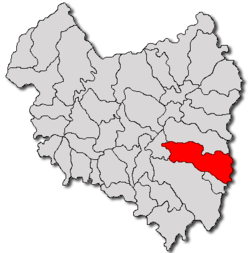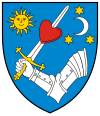Covasna
Covasna
Kovászna | |
|---|---|
Town | |
| The main square The main square | |
 Location of Covasna | |
| Country | |
| County | Covasna County |
| Status | Town |
| Government | |
| • Mayor | Lőrincz Zsigmond (UDMR) |
| Area | |
| • Total | 155.11 km2 (59.89 sq mi) |
| Population (2004) | |
| • Total | 11,369 |
| Time zone | UTC+2 (EET) |
| • Summer (DST) | UTC+3 (EEST) |
| Website | Town website |
Covasna (Romanian pronunciation: [koˈvasna]; Hungarian: Kovászna, Hungarian pronunciation: [koˈvasna] ; German: Kowasna) is a town in Covasna county, Transylvania, Romania, at an altitude of 550–600 m.
Known as the "town of 1,000 mineral springs," Covasna is famous for its mineral waters. Each spring has a different mixture of minerals, chiefly carbon dioxide, sulfur, and ammonia. Its name is derived from the Slavic word Cvaz, meaning sour, referring to the taste of its mineral waters.
Chiuruş
The town administers one village, Chiuruş (Hungarian: Csomakőrös). The village has a population of 451 and has an absolute Székely Hungarian majority.
Demographics
According to the 2011 Census, Covasna has 10,265 inhabitants. It has a Hungarian majority: 7,549 or 66.4%. 3,672 (32.3%) Romanians also live in the town.
Demographic movement according to the censuses:

History
- 1567 - First mentioned in a document.
- 1952 - Covasna became a town.
Famous natives
The famous Hungarian explorer and linguist Sándor Kőrösi Csoma was born in Chiuruş/Csomakőrös in 1784. Kőrösi is widely seen as the founder of Tibetology, he was the compiler and author of the first Tibetan-English dictionary and grammar book. He died in Darjeeling, India in 1842.
A statue in his honour was erected in the centre of the village in 1972 and there is an exhibition in the cultural centre.
External links
- www.cosys.ro/kovaszna/rom - unofficial site of the town of Covasna, accessible in Romanian, Hungarian and English
- www.covasna.tk - unofficial site of the town of Covasna in English, Hungarian, German and Romanian
- Covasna Accommodation -information about accommodation possibilities in Covasna


